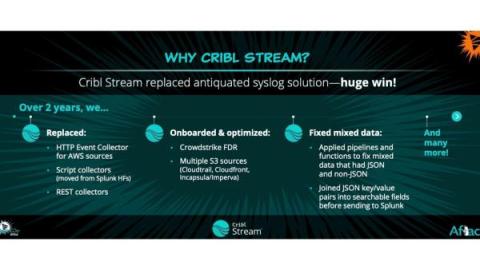Operations | Monitoring | ITSM | DevOps | Cloud
Search
Cribl Stream's Replay vs Cribl Search's Send: Understanding the Differences
In today’s contemporary landscape, organizations produce more data than ever, which needs to be collected, stored, analyzed, and retained, but not necessarily in that order. Historically, most vendors’ analysis tools were also the retention point for that data. Still, while this may first appear to be the best option for performance, we have quickly seen it creates significant problems.
Performing Geolocation Lookups on IP Addresses to Use in Cribl Search
Are you tired of sifting through data without context? Cribl Search adds valuable depth to your data, making it much easier to understand and analyze. No more squinting at cryptic logs or puzzling over unknown IP addresses! ️ Some common examples of how Cribl Search can enrich your data are adding service names or matching to threat intelligence. Another popular data enrichment is adding geographical location to events based on IP addresses.
Generating and Comparing Statistics with Eventstats in Cribl Search
When exploring data, comparing individual data points with overall statistics for a large data set is often useful. For example, you might be interested in understanding when a performance metric rises above the historical average. Or possibly knowing when the variance of that metric increases past a certain threshold. Or maybe noting a change in the distinct number of IP addresses connecting to your public web portal.
Understanding the difference between OpenSearch and Elasticsearch
Enrichment: Better Data in for Better Response Times Out
In this conversation, Cribl’s Carley Rosato talks to Aflac’s Shawn Cannon about his role as a Threat Management Consultant, and how he manages their SIEM environment, brings in new data as needed, and works to improve the ingestion process. Our customers are always coming up with new and exciting ways to implement Cribl tools — importing a 34 million-row CSV file into Redis and enriching events in Splunk might be one of the most impressive we’ve seen so far.
Searching the Google Workspace API using Cribl Search
Google Workspace is a robust set of productivity applications with billions of users and millions of paying organizations. These include small mom-and-pop shops and the largest enterprises. Google provides the Google Reports API, “a RESTful API you can use to access information about the Google Workspace activities of your users.” This data is critical for establishing a solid security posture.
Cribl Search & Parquet Pushdowns - Smooth Like Butter!
Data is growing, and we are being asked to search larger and larger amounts of data. This puts larger and larger demands on Search resources. Reading all the data to find matching events is muscling through the data. Wouldn’t it be more efficient to be able to do filtering before reading the data? Cribl Search does precisely that by leveraging Parquet Pushdowns.
Buyer Beware! Three Challenges with Elasticsearch and OpenSearch
Elasticsearch and OpenSearch are powerful enterprise search and analytics engines that have become popular in the world of data management and telemetry analysis. Their ability to swiftly search, analyze, and visualize data has made them indispensable for businesses and organizations. However, in this blog, we will explore a few key challenges faced by companies using Elasticsearch and OpenSearch, shedding light on important considerations when selecting the right tool for your needs.
Paving the way for modern search workflows and generative AI apps
Elastic’s innovative investments to support an open ecosystem and a simpler developer experience In this blog, we want to share the investments that Elastic® is making to simplify your experience as you build AI applications. We know that developers have to stay nimble in today’s fast-evolving AI environment. Yet, common challenges make building generative AI applications needlessly rigid and complicated. To name just a few.







